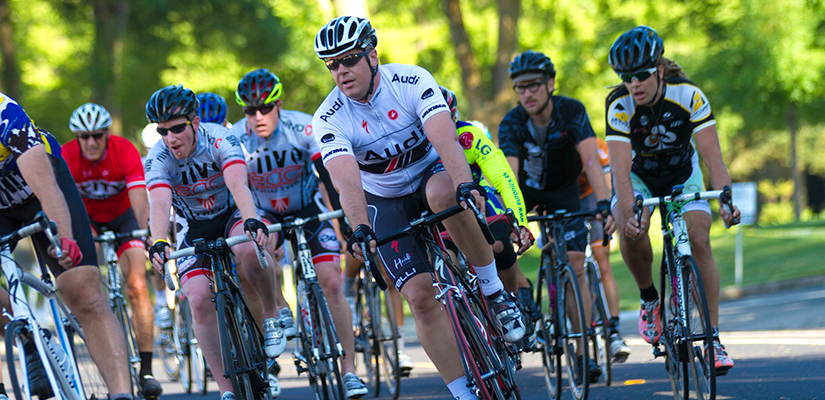Train Hard, Race Light

Of all the numbers a cyclist keeps track of, the most telling indicator of their speed is their power-to-weight ratio (often times expresses as watts per kilogram). The pursuit to become a faster cyclist normally places us on either side of this ratio, and in some cases, we find ourselves on the extreme ends of the spectrum.
For some, the goal of losing weight can take priority over everything else. Constantly counting calories and being more concerned with what the scale is going to read rather than meeting the nutritional needs of an endurance athlete will often lead to both lower weight and watts.
On the other side of the spectrum are the athletes who are only interested in boosting their FTP by any means necessary. With a mindset of “I’ll burn it off”, these riders eat what they want, when they want, and stick to extremely high intensity intervals on a regular basis, as these are known to provide the biggest boost in threshold. While FTP usually does go up (before quickly reaching a plateau), an ideal “race weight” is never reached and thus watts/kilo shows minimal improvement.
These are extreme examples, but every cyclist is probably leaning in one direction or another on this spectrum. While both weight and power are important, only a healthy respect and focus for both can allow an athlete to make serious improvements to their speed. So what’s the secret to doing this? Balance, structure, and consistent hard work.
With that, I’d like to introduce you to Dave, an avid TrainerRoad user with a powerful success story that perfectly embodies the balance, structure, and hard work that we at TR preach to our athletes.
“Eat, drink, rave, repeat” is a saying my kids use. Honestly, not sure what it means but I feel that it implies a process for doing something you enjoy over and over and over again. Prior to TrainerRoad I had the same mantra, just a bit easier for me to understand using words I related to when it came to cycling. Maybe you relate – “Ride longer, go faster, and don’t forget to pedal harder”! That was my training methodology for many years – sure I’d heard about intervals, power, W/kg, etc. but none of it meant anything to me. I was, and still am, a busy career minded individual focused on doing well at work and raising my family – I’m not a professional bike rider, rather a recreational racer who always strives to do better.”
Dave picked cycling back up about 6 years ago but felt as though he was unable to reach his full potential as an athlete for two reasons:
“1. I ate poorly and my weight wasn’t healthy as I peaked at close to 250 lbs about four years ago (a dangerous level according to my doctor).
2. I didn’t know how to train – eat, drink, rave, repeat – right?”
Dave identified room for improvement on both sides of his power-to-weight ratio. Rather than seeking easy results, he went after real results through 2 steps:
“1. My wife and I changed the way we ate – gone were all the processed, sugar and fat laden foods that we loved. We replaced them with fruits, vegetables and lean proteins – all the stuff we should eat. My weight dropped to 180 – for a 6’1 guy that felt great. I know I’ll never be a light-weight climber, but dropping the combined weight of two toddlers definitely helped me feel better physically, emotionally and mentally.
2. I discovered TrainerRoad. With this discovery I moved away from my non-focused training cycle of “Riding longer, Going faster, and Pedaling harder”. All of a sudden I had a plan, something that focused me on measurable improvements. I slowly saw my FTP grow and, as I religiously followed the training plans, I ultimately jumped to an FTP of 281 – that output, combined with my weight loss, shot my W/kg to 3.46. “

By taking his diet by the horns and incorporating a well-rounded and structured training plan, Dave was able to drop his weight by 25% and raise his power by 20%. Looking at the before picture from the top of this post, and the after photo above, you can see how much progress Dave has made.
Dave did what all cyclists strive to do – he lowered his weight and increased his power.
What You Can Do:
Identify strengths and weaknesses
How close to “race weight” are you? What areas of your fitness were strong points last season and what were your weak points? Ideal power-to-weight ratios can only be achieved if you know exactly what you are striving for from the start. By being honest with yourself as an athlete and a person, you can identify where you can improve and how – then you can start working towards it.
Create a Plan
Let’s say you are 15 lbs. over “race weight” and your first race is in two weeks. Dropping 15 lbs. in two weeks is sure to hurt your performance. Plus, if you drop that much weight in that timeframe, it’s almost guaranteed to come back on immediately. Instead, look beyond the first race and take control of the rest of your season. A healthy weekly weight loss for most athletes is 2-3 lbs. With that in mind, you can plan to slowly take off the weight over the next month, while still being able to race/train at full power. Be careful and smart about dropping weight, and refer back to my prior posts on the subject for advice:
In regards to your fitness, lets say you wanted to improve your sustained power for long climbs, and your primary event is 16 weeks out. Rather than burning yourself out doing threshold intervals over and over, day after day, follow a Build and then a Specialty plan. Having progressive, structured training plans to follow will prevent early peaks and keep you steadily growing/adapting as the year goes on.
Monitor
You’ve reached race weight and you have your workouts planned for the next 4 months. Now what?
This is the time to monitor, fine tune and make small adjustments. You want to make sure you’re getting enough calories, while also preventing weight gain. Further, you want to assess the training and how your body is responding to this. If you have small races throughout the year leading up to your big event, you can use these to judge where you’re at and how things are going. Perhaps there is a different area of your fitness that needs to be tended to? Perhaps you’re feeling tired and need to take a few days off entirely? Or, perhaps things are going perfectly and you feel as though you may benefit from bumping up from the Low Volume to the Mid Volume version of the plan you’re on?
Be inquisitive and honest with yourself through this process. You know yourself better than anybody else. Identifying problems or ways to improve early on will pay off tremendously as the year goes on. And remember, you can’t expect different results if you’re always doing the same thing.